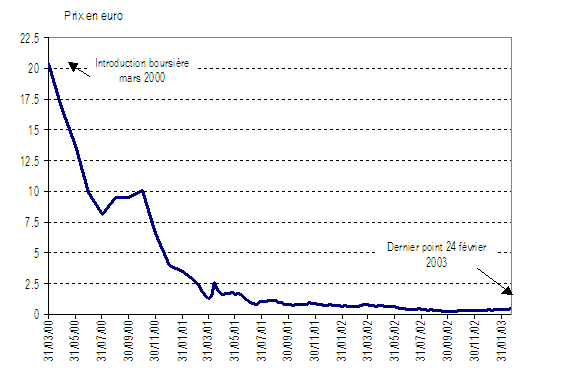ANNEXE 2 - L'INTRODUCTION BOURSIÈRE DE LYCOS EUROPE NV EN MARS 2000
En mars 2000, LYCOS Europe, un portail internet, a été introduit à la bourse. L'offre public d'achat (OPA) à été fortement souscrite par des zinzins européens, ce qu'a attiré aussi la demande des particuliers. La demande élevée poussait le prix de l'émission vers le haut de l'interval choisi par les vendeurs (24 euros), dû à une sur-souscription de facteur 30 100( * ) . A l'heure de rédaction, l'action est valorisé à 0.45 euro. Elle a perdu 98% de son valeur initial.
Graphique 38 - L'évolution du titre Lycos Europe depuis son OPA

LYCOS
EUROPE N.V. INITIAL PUBLIC OFFERING OFFER PRICE FIXED AT EURO 24
Lycos Europe N.V. today announced the successful completion of its Initial
Public Offering, the details of which are as follows: The Offer Price of the
shares is Euro 24, representing the top of the bookbuilding price range of Euro
19 to Euro 24. The Offer was more than 30 times subscribed.
Strong demand
from European institutional investors and German retail investors
.
The Offering comprises 28 million newly issued shares, representing
approximately 12.3% free float, and is valued at approximately Euro 672 million.
Additionally, the Company has granted the underwriters an over-allotment option
of up to a further 4.2 million newly issued shares valued at Euro 101 million.
Assuming full exercise of the over-allotment option, the Offering will be
valued at Euro 773 million, and will result in a free float of 13.9%.
Listing and trading to start on the Neuer Markt at the Frankfurt Stock Exchange
on Wednesday, 22 March.
SIZE AND STRUCTURE OF THE OFFER
The IPO of Lycos Europe N.V. represented approximately 12.3% of the Company's
share capital and was comprised of 28 million newly issued shares, not
including the over-allotment option of up to 4.2 million newly issued shares.
The indicative price range was set at between Euro 19 and Euro 24 on Monday, 13
March. The final price of the shares was determined to be Euro 24 following the
bookbuilding process.
The Offering raised Euro 672 million. Assuming full exercise of the
over-allotment option total proceeds will amount to Euro 773 million. All
shares were offered through a capital increase, and existing shareholders did
not sell any shares in the offering. "The unconditional support of Bertelsmann,
Gruner + Jahr and Lycos, Inc. remains an important factor in the continuing
development of our Company", said Christoph Mohn, referring to the shareholder
structure after the Offer.
The Offer was extremely well received by investors and was heavily
oversubscribed. The main sources of demand were European institutional
investors and German retail investors. In proportion to the number of shares
they subscribed for, German retail investors received an over-proportionally
large allocation of the shares available in the IPO.
COMMENT
Christoph Mohn, CEO of Lycos Europe N.V., said today: "I am extremely
enthusiastic about the confident reception by investors to the IPO of Lycos
Europe N.V. The interest that they expressed during the roadshow presentations
gave us an indication that our IPO would be well received. We believe that the
demand for our shares indicates that investors are convinced by our strategy of
being a pan-European internet portal with strong brands. We are now looking
forward to the first day of trading and to a long and successful relationship
with our new shareholders."
STRATEGY FOR GROWTH
The Company intends to use the proceeds from the offering to support its
expansion strategy, including the improvement of existing services, the
introduction of new services, an increase in marketing activities and potential
acquisitions and joint ventures.
The Company aims to increase and retain traffic by expanding the reach of the
network, as demonstrated by the multi-brand strategy pursued by the Company.
The Company covers navigation and content, community and Internet access
through the Lycos, Fireball, Tripod and Comundo brands.
The Company also aims to increase the frequency and duration of user visits
through the development of existing and the addition of new brands (HotBot and
Sonique for navigation and content, and Angelfire for community). New services,
cross-promotion within the network, and the use of new platforms such as WAP
(Wireless Application Protocol), are further elements of the growth strategy.
The Company also aims to increase the frequency and duration of user visits by
continually improving content and functionality.
OWNERSHIP STRUCTURE
Prior to the offering, Lycos, Inc. held 50.0% of the share capital of the
Company, Bertelsmann AG and Gruner + Jahr AG & Co. held 31.1% of the share
capital, and the remaining 18.9% was held by Christoph Mohn, Chief Executive
Officer of Lycos Europe N.V., partly through indirect ownership.
After the offering and before the exercise of the over-allotment option, Lycos,
Inc. own 43.9% of the Company, Bertelsmann AG and Gruner + Jahr AG & Co.
own 27.3% of the Company, Christoph Mohn own 16.5% of the Company (partly
through indirect ownership), and the remaining 12.3% is free float.
After the offering and after the exercise of the over-allotment option, Lycos,
Inc. will own 43.1% of the Company, Bertelsmann AG and Gruner + Jahr AG &
Co. will own 26.8% of the Company, Christoph Mohn will own 16.2% of the Company
(partly through indirect ownership), and the remaining 13.9% will be free float.
Lycos Europe N.V. appointed Deutsche Bank and Goldman Sachs to act as Joint
Global Co-Ordinators and bookrunners for the offering. In addition, the
underwriting syndicate comprised Commerzbank, JP Morgan and Chase H&Q.
Source :
http://www.lycos.de/service/cce/investor_relations/fnachrichten/newsitem_16.html
Bibliographie
Anlagegezets Versicherungsunternehmen An/V, 2001
Bank for International Settlements (1993), «63rd Annual Report», BRI
Basle.
Bank for International Settlements (1995), «65th Annual Report», BRI
Basle.
Bank for International Settlements (1998), «68th Annual Report», BRI
Basle.
Benos A et Crouhy M (1996), "Changes in the structure and dynamics of European
securities markets", Financial Analysts Journal, May/June, 37-50.
Berger A et Udell G (1992), «Securitisation, risk and the liquidity
problem in banking», Working Paper S-92-2, Salomon Center, New York
University
Berger A, Kashyap A K et Scalise J M (1995), "The transformation of the US
banking industry, what a long strange trip it's been", Brookings Papers,
2:1995, 55-218
Berglöf E (1996), "Corporate governance", in ed. B Steil «The
European Equity Markets», Royal Institute of International Affairs, London
Blake D (1992), "Issues in pension funding", Routledge, London.
Blake D (1996), «Portfolio choice models of pension funds and life
insurance companies; similarities and differences», Discussion Paper No.
PI-9610, The Pensions Institute, Birkbeck College, London.
Blake D (1997), "Pension funds and capital markets", Discussion Paper No
PI-9706, The Pensions Institute, Birkbeck College, London.
Blake D (1999), «Portfolio choice models of pension funds and life
assurance companies, similarities and differences», Geneva Papers on Risk
and Insurance, 24, 327-57.
Blake D et Hudson R (2000), «Improving security and flexibility in
retirement; full technical report», Retirement Income Working Party, London
Bodie Z (1990b), "Pensions as retirement income insurance", Journal of Economic
Literature, Vol 28, 28-49.
Bodie Z (1991), "Shortfall risk and pension fund asset management", Financial
Analysts Journal, May/June 1991.
Bodie Z et Davis E P (eds) (2000), "The Foundations of Pension Finance", Edward
Elgar
Bodie Z, Kane A and Marcus A J (1996), "Investments", Irwin.
Broby D (1997), "The changing face of European fund management", FT Financial
Publishing
Cardinale M, Findlater A et Orszag M (2002), «Paying out pensions; a
review of international annuities markets», Research Report 2002-RU07,
Watson Wyatt, Reigate.
Cutler D, Poterba J et Summers L (1990), "Speculative Dynamics and the role of
feedback traders", American Economic Review, 80, Papers and Proceedings.
Davis E P (1994), "Market liquidity risk", in eds. Fair D. and Raymond R.,
«The Competitiveness of Financial Institutions and Centres in
Europe», Kluwer Academic Publishers
Davis E P (1995a), «Pension funds, retirement-income security and capital
markets - an international perspective», Oxford University Press.
Davis E P (1995b), «Debt, financial fragility and systemic risk, revised
and extended version», Oxford University Press.
Davis E P (1995), «Pension funds, retirement-income security and capital
markets - an international perspective», Oxford University Press.
Davis E P (1996), "Pension Fund Investments", in B. Steil et al "The European
Equity Markets, the State of the Union and an Agenda for the Millennium", The
Royal Institute of International Affairs, London
Davis E P (1996b), «The role of institutional investors in the evolution of financial structure and behaviour», LSE Financial Markets Group Special Paper No 89.
Davis E P
(1998b), "Investment of mandatory funded pension schemes", Discussion Paper No.
PI-9908, the Pensions Institute, Birkbeck College, London
Davis E P (2000), «Regulation of private pensions, a case study of the
UK», Working Paper No PI-2009, The Pensions Institute, Birkbeck College,
London, and forthcoming in Revue d'Economie Financiere
Davis E P (2002a), «Prudent person rules or quantitative restrictions? The
regulation of long term institutional investors' portfolios», Journal of
Pensions Economics and Finance, 1, 157-191
Davis E P (2002b), «Issues in the regulation of annuities markets»,
CERP Working paper No 26/02, Center for Research on Pensions and Welfare
Policies, Turin
Davis E P et Steil B (2000), «Institutional investors», MIT Press
Dermine J et Röller L H (1992), "Economies of scale and scope in French
mutual funds", Journal of Financial Intermediation, 2, 83-93.
DeLong, J.B., Shleifer A., Summers L., et Waldman R. (1990), «Positive
feedback investment strategies and destabilising rational speculation»,
Journal of Finance, 45, 379-95.
Friedman, Milton (1953), «The case for flexible exchange rates, in Milton
Friedman, ed.: Essays in Positive Economics», University of Chicago Press,
Chicago, IL.
Froot K.A., Scharfstein D.S., et Stein J.C. (1992), «Herd on the Street:
Informational Inefficiencies in a Market with Short-Term Speculation», The
Journal of Finance, 47, 1461-84.
Grossman S et Stiglitz J E (1980), "On the impossibility of informationally
efficient markets", American Economic Review, 70, 393-408.
Keynes J M (1936), "General theory of employment, interest and money",
MacMillan, London.
Lakonishok J, Schleifer A et Vishny R W (1991), "Do institutional investors
destabilize share prices? Evidence on herding and feedback trading" Working
Paper No. 3846, National bureau of Economic Research.
Plihon D et Ponssard J-P ed (2002) « La montée en puissance
des fonds d'investissement. Quels enjeux pour les
entreprises ? », Les études de La documentation
française.
Rybczynski T (1995), "The development of European capital markets: the main
trends and their implications", in ed J Revell «The changing face of
European banks and securities markets», MacMillan, London.
Sauviat C (2001) « Syndicats et marchés financiers : bilan et
limites des stratégies nord-américaines. Quelle valeur d'exemple
pour les syndicats en Europe ? », Revue de l'IRES, 2001/2, pp
1-33.
Scharfstein D S et Stein J C (1990), "Herd behaviour and investment", American
Economic Review, 80, 465-79.
Schwarz R A et Steil B (1996), "Equity trading III; institutional investor
trading practices and preferences", in ed. B Steil «The European Equity
Markets», Royal Institute of International Affairs, London
Shiller, Robert (1988) «Portfolio insurance and other investor fashions as
factors in the 1987 stock market crash», NBER Macroeconomics Annual
Shiller R J (1990), "Market volatility", MIT Press, Cambridge, Mass.
Sørensen Ole Beier , « Le système de retraite du
Danemark », Revue de L'AFPEN, n:18, Janvier 2003







